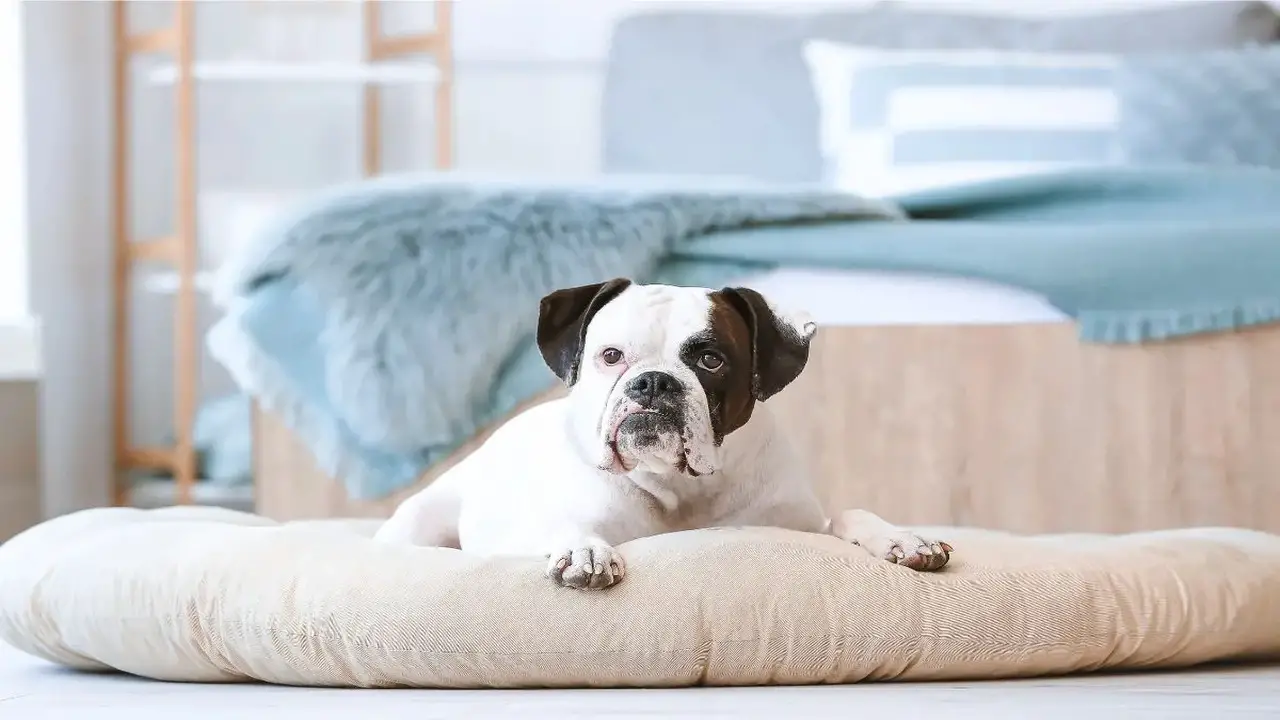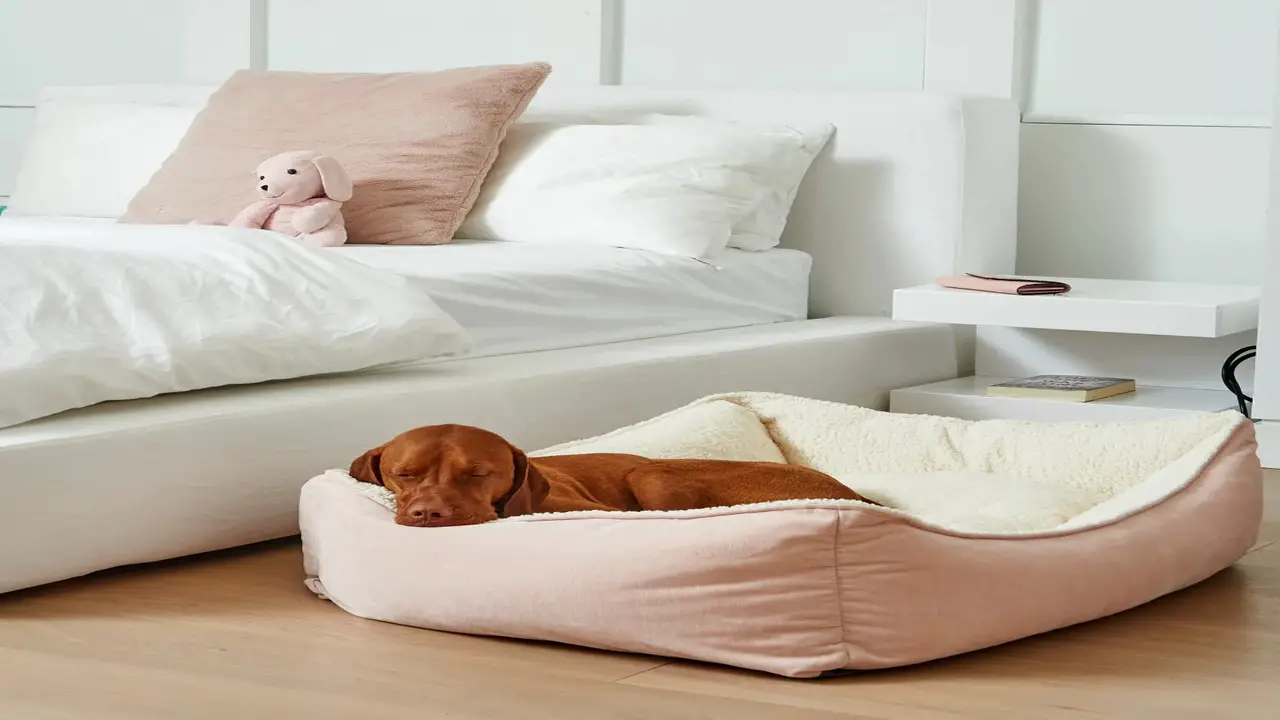The decision to transition your furry friend from a crate to a dog bed is a significant milestone in their development. It indicates that your pet has outgrown its crate and is ready for more freedom and independence.
However, this change can be challenging, as dogs can attach to their crates. Fortunately, with proper planning and patience, you can make the transition from crate to dog bed a smooth shift for you and your canine companion.
We will be sharing some practical tips and strategies to help you make the transition from crate to dog-bed a seamless process. We will explore the benefits of transitioning your dog from crates to beds. The signs that your dog is ready for the shift and the steps you must take to ensure your pet is comfortable in its new sleeping quarters.

Why Transition From A Crate To A Dog Bed?

Transitioning from a crate to a dog bed offers your furry friend more space and freedom to stretch out. It promotes better sleep quality and comfort while reinforcing good behavior and training. As your dog grows older and becomes more independent, the transition can provide a sense of ownership and personal space.
How To Transition From Crate To Dog Bed Easily

Transitioning from a crate to a dog bed is important for your dog’s development and comfort. While crates provide security and containment. Transitioning to a dog bed can offer more freedom and comfort for your furry friend. It allows them to have space to relax and sleep comfortably without feeling confined.
Additionally, a dog bed can help promote joint health by providing cushioning and support for your dog’s body. When making the transition, it’s important to make the dog bed an inviting and positive space by using treats or toys to encourage your dog to use it.
With time and patience, your dog will adjust to their new sleeping arrangement and enjoy the benefits of having their own cozy spot. Here is how to transition from crate to dog bed Easily.
Signs That Your Dog Is Ready To Transition
As a responsible dog owner, it’s important to recognize the signs that your furry friend is ready to transition from their crate to their own bed. One key indicator is when your dog no longer shows any signs of anxiety or distress inside the crate.
This could include excessive barking, whining, or scratching at the crate door. Another sign is if they consistently sleep through the night without going potty. This shows they have developed bladder control and can hold it until morning.
You can also tell your dog is ready to transition when they willingly go into their dog bed on their own during nap times. This demonstrates that they are comfortable and trust their new sleeping space. Additionally, if they seem relaxed and content when lying in the dog bed, it strongly indicates they are ready for the switch.
Creating A Comfortable And Inviting Dog Bed Space

To create a comfortable and inviting dog bed space, choosing a bed that suits your dog’s size and comfort preferences is important. Dogs come in different sizes and have varying sleep preferences, so finding the right dog bed is crucial. Ensure that the dog bed is placed in a quiet and calm area of your home to provide a peaceful sleeping environment for your furry friend. It should be away from high-traffic areas to minimize disturbances during nap times.
To make the dog bed more inviting, consider adding blankets or bedding that smells familiar to your dog. This can help create a sense of security and comfort, making the bed a cozy retreat. In addition, you may want to puppy-proof the surroundings by using baby gates or creating a safe space around the dog bed. This can prevent distractions and provide a designated area for relaxation.
Introducing The Dog Bed As A Positive And Rewarding Experience
To introduce the dog bed as a positive and rewarding experience for your furry friend, there are a few effective strategies you can employ. Firstly, enticing your dog to explore the dog bed by placing treats or toys inside can spark their curiosity and make them more receptive to using it. Positive reinforcement, such as praise or treats, when your dog voluntarily uses the dog bed establishes a positive association with this new sleeping arrangement.
It’s essential to associate the dog bed with positive experiences, such as bedtime or nap time routines. By incorporating the dog bed into these comforting rituals, your dog will begin to view it as a safe and enjoyable space. It’s crucial to avoid forcing or coercing your dog onto the dog bed, as this may create negative associations and resistance. Instead, allow them to use the dog bed on their own terms.
Creating a comfortable and inviting atmosphere for the dog bed is also vital. Ensure that the bed is the right size and comfort level for your dog, and place it in a quiet and calm area of your home. Adding blankets or bedding with familiar scents can make the bed even more inviting. By incorporating these strategies, you can help your dog transition smoothly from the crate to its bed and make it a positive and rewarding experience.
Gradual Transitioning Process And Patience
To successfully transition your dog from the crate to its own bed, it’s important to follow a gradual process and practice patience. Start by gradually increasing your dog’s time in the dog bed each day. Begin with short periods of time and gradually extend the duration as your dog becomes more comfortable. This will help them adjust to the new sleeping arrangement at their own pace.
During the transition period, it’s essential to be patient and understanding. Some dogs may take longer to adapt to the change, and that’s okay. Offer plenty of encouragement and praise when your dog uses the dog bed. Positive reinforcement can help reinforce the behavior and make the transition smoother.
Avoid rushing the process or forcing your dog onto the bed. Allow them to explore and get accustomed to the new sleeping space on their own terms. Remember, every dog is different and may need varying amounts of time to adjust. Be patient and trust the process.
Dealing With Any Anxiety Or Resistance During The Transition

During the transition from crate to dog bed, it’s not uncommon for some dogs to experience anxiety or resistance. If your dog shows signs of unease, you can try a few techniques to help calm them down. Consider using calming techniques such as aromatherapy or soothing music to create a relaxing environment for your pooch. Additionally, it may be helpful to consult with a veterinarian or professional dog trainer for guidance and support.
You can use a crate door or cover on the dog bed to provide a sense of security and familiarity. This can help your dog feel more comfortable during the transition period. Providing extra attention and reassurance during this time can also help alleviate any anxiety your dog may be experiencing. Be consistent in your approach, and avoid reverting to using the crate if your dog shows resistance.
Tips For The Successful Crate Dog Bed Transition
Transitioning from a crate to a dog bed can be a smooth and stress-free process for you and your furry friend. The key to a successful transition is gradual training and positive reinforcement. Start by placing the dog bed next to the crate and encourage your dog to explore it. Here are some tips to help make this transition successful:
- Gradual introduction: Start by placing the dog bed inside the crate, allowing your dog to become familiar with it while still feeling secure in their crate.
- Positive reinforcement: Use treats, praise, and rewards to encourage your dog to spend time on the bed. Start by rewarding them for approaching the bed and gradually increase the criteria.
- Comfort and familiarity: Make the dog bed inviting by adding familiar bedding or toys with their scent. This will help create a sense of comfort and security.
- Encourage relaxation: Teach your dog cues like “go to your bed” or “settle” to encourage them to use the dog bed for relaxation. Reward them when they choose to lie down on it voluntarily.
- Patience and consistency: Transitioning from a crate to a dog bed may take time, especially if your dog is used to sleeping in their crate. Be patient and consistent with the training process, providing clear expectations and positive reinforcement.
Following these tips can help your dog successfully transition from a crate to a comfortable and cozy dog bed.
Consistency And Routine In The New Sleeping Arrangement
Establishing consistency and routine in the new sleeping arrangement is crucial for a smooth transition from crate to dog-bed. One of the first steps is to create a consistent bedtime routine, including settling your dog into its own bed. This can help signal your dog that it’s time to relax and sleep.
In addition to a bedtime routine, maintaining a regular schedule for feeding, exercise, and bathroom breaks can help regulate your dog’s sleep patterns. Dogs thrive on routine, so sticking to a consistent schedule can help them feel more secure and comfortable in their new sleeping arrangement.
Monitoring And Adjusting As Needed For Your Dog’s Comfort

During the transition from crate to dog-bed, it’s important to closely monitor and adjust as needed to ensure your dog’s comfort. Pay attention to any changes in your dog’s behavior or sleep patterns, as these can indicate their comfort level in their new sleeping arrangement. Consider consulting with a veterinarian for guidance if you notice any signs of discomfort or resistance.
Monitor your dog’s comfort level in the dog bed and adjust the bedding or placement if necessary. Some dogs prefer a softer or firmer bed, while others prefer a specific position or location in the room. You can create an environment that promotes restful sleep and relaxation by being attentive to their needs and making necessary adjustments.
Remember to check the condition of the dog bed itself regularly. Over time, the bed may become worn or uncomfortable, so it’s important to replace it if needed. Your dog’s comfort should always be a priority, so be flexible and willing to make adjustments to ensure their well-being.
Conclusion
Transitioning from a crate to a dog bed is important in ensuring your furry friend’s comfort and independence. It allows them to have their own space while feeling safe and secure. By paying attention to your dog’s readiness, creating a comfortable environment, and introducing the dog bed positively, you can make this transition smooth and stress-free.
Being patient and understanding is important, as each dog may have different anxiety levels or resistance during this process. Consistency and routine in the new sleeping arrangement will help your dog adjust successfully.
Monitor and adjust as needed to ensure your dog’s comfort and happiness in its new sleeping space. We have provided bulk information on how to transition from crate to dog bed easily and hope our information was helpful from your perspective.
Frequently Asked Questions
How To Transition My Dog Out Of His Crate?
Gradually increase your dog’s time outside the crate and introduce a comfortable dog bed in a designated area. Use positive reinforcement, like treats and praise, to encourage your dog to use the new bed. Monitor behavior and adjust the transition as needed.
When Can I Transition My Dog From Crate To Bed?
The timing of transitioning your dog from a crate to a bed depends on their individual needs and behavior. Wait until they are comfortable being left alone without destroying things or having accidents. Start by placing the bed inside the crate and gradually remove the walls until only the bed is left. Monitor their behavior during the transition and be patient as they adjust.
When Is Your Puppy Ready To Sleep Out Of The Crate?
Puppies are typically ready to sleep out of the crate at around 6 months old. Signs of readiness include being potty trained and not chewing on furniture. Start by placing the dog bed near the crate and gradually move it further away. Use positive reinforcement during the transition process.
How Do You Teach Your Puppy To Sleep Outside The Crate?
Gradually increase your puppy’s time outside the crate using positive reinforcement. Encourage them to use their new dog bed by placing treats or toys on it. Be patient and consistent in training them to sleep outside the crate.
How Do You Train A Dog To Transition From A Crate To A Dog Bed?
To train your dog to transition from a crate to a dog bed, start by placing the bed in the same room as the crate. Encourage exploration and use by placing treats or toys on the bed. Gradually increase bedtime and decrease crate use, rewarding your dog for using the bed.

Aquarium passion is all about connecting with the aquatic life and providing education to the public on the importance of these creatures. We showcase a wide variety of marine life through our exhibits as well as working with schools to provide unique learning opportunities for students of all ages.





